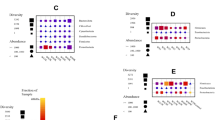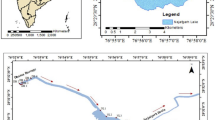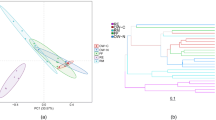Abstract
Diver collected cores from three sites in Lake Erie, west of Cleveland, Eastern basin and near Buffalo, and one from Lake Ontario near the mouth of the Niagara River, were sectioned to 20 cm and examined for sulfur cycle and nitrogen cycle bacteria, heterotrophic bacteria, insoluble organic and inorganic phosphate solubilizing bacteria and manganese oxidizing bacteria. Eh, pH, nitrogen, organic carbon and percentage moisture determinations were also made.
Data from this study support and confirm other microbiological data collected from Lower Great Lakes sediment and also support the hypothesis that microbial flora of similar type sediments are numerically similar irrespective of the sediments source within the Lower Great Lakes.
Similar content being viewed by others
References
Alexander, M., 1965. Methods of soil analysis, 2. In: Black, C. A. (Ed.) Chemical and microbiological properties, Agronomy Inc., Madison, Wis.
Allen, O. N., 1953. Experiments in soil bacteriology. Burges Publishing Co.
American Public Health Association, 1974. Standard methods for the analysis of water and waste water. 13th ed. APHA Inc., N.Y. 874 pp.
Ayyakkannu, K. & Chandramohan, D., 1971. Occurrence and distribution of phosphatase solubilizing bacteria and phosphatase in marine sediments at Porto Novo. Mar. Biol. 11: 201–205.
Bell, J. B. & Dutka, B. J., 1972. Microbiological examination of Lake Ontario sediments: II. Heterotroph methodology comparison. Proc. 15th Conf. Gt Lakes Res.: 9–14.
Doetsch, R. N. & Cook, T. M., 1973. Introduction to bacteria and their ecobiology. Univ. Park Press, Baltimore, Md. 371 pp.
Dutka, B. J., Bell, J. B. & Liu, D. L. S., 1974. Microbiological examination of offshore Lake Erie sediments. J. Fish. Res. Bd Can. 31: 299–308.
Fenchel, T. B. & Jorgensen, B. B., 1977. Detritus food chain of aquatic ecosystems: the role of bacteria. 4. Anaerobic decomposition. In: Alexander, M. (Ed.) Advances in microbial ecology, N.Y., Plenum Press 1: 21–31.
Gunkel, W. & Oppenheimer, C. H., 1963. Experiments regarding the sulfide formation in sediments of the Texas Gulf Coast. In: Oppenheimer, C. H. (Ed.) Symposium on Marine Microbiology. Charles C. Thomas, Springfield, Ill.
Hargrave, B. J., 1972a. Oxidation-reduction potentials, oxygen concentration and oxygen uptake of profoundal sediments in a eutrophic lake. Oikos 167–177.
Hargrave, B. J., 1972b. Aerobic decomposition of sediment and detritus as a function of particle surface area and organic content. Limnol. Oceanogr. 17: 583–596.
Jones, J. G., 1971. Studies on freshwater bacteria. Factors which influence the population and its activity. J. Ecol. 59: 593–613.
Keeney, D. R. & Bremnen, J. M., 1967. Use of the Coleman Model 29A analyser for total nitrogen analysis of soils. Soil Sci. 104: 358–363.
Kemp, A. L. W. & Lewis, C. F. M., 1968. A preliminary investigation of chlorophyll degradation products in the sediments of Lakes Erie and Ontario. Proc. 11th Conf. Gt Lakes Res.: 206–229.
Marty, D., 1981. Distribution of different anaerobic bacteria in Arabian sea sediments. Mar. Biol. 63: 277–281.
Menon, A. S., Marion, C. V. & Miller, A. N., 1972. Microbiological studies related to oxygen depletion and nutrient regeneration processes in the Lake Erie Central Basin. Project Hypo. CCIW Pap. 6, U.S. EPA Tech. Rep. TS-05–71–20824.
Odoevskaia, N. S., 1961. New media for Bac megaterium var. phosphaticum in soil. Bull. sci. tech. Inf. Agric. Microbiol. 10: 30–32.
Postgate, J. R., 1966. Media for sulfur bacteria. Lab. Pract. 15: 1239–1244.
Starkey, R. L., 1948. Characteristics and cultivation of sulfatereducing bacteria. J. am. Wat. Wks. Ass. 40: 1291–1298.
Taylor, C. B., 1940. Bacteriology, of freshwater. I. Distribution of bacteria in English lakes. J. Hyg. 40: 616–640.
Thompson, F., 1969. An investigation into the distribution and autotrophic and heterotrophic bacteria in Little Round Lake, with particular emphasis on some bacterial agents at the sulfur cycle. Bacteriol. Branch. Lab. Div. Ont. Wat. Res. Comm. Toronto Can. 17 pp.
Timonin, M. I., Illman, W. I. & Hartgerink, T., 1972. Oxidation of manganous salts of manganese by soil fungi. Can. J. Microbiol. 18: 793–799.
Vanderpost, J. M., 1972. Bacterial and physical characteristics of Lake Ontario sediment during several months. Proc. 15th Conf. Gt. Lakes Res. 198–213.
Weeks, O. B., 1944. Populations of heterotrophic bacteria in two sediment layers of Western Lake Erie. J. Bacteriol. 47: 446–447.
Author information
Authors and Affiliations
Rights and permissions
About this article
Cite this article
Dutka, B.J., Kwan, K.K. Microbiological examination of Lake Erie and Lake Ontario sediments. Hydrobiologia 98, 135–145 (1983). https://doi.org/10.1007/BF02185631
Received:
Revised:
Issue Date:
DOI: https://doi.org/10.1007/BF02185631




